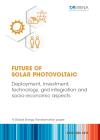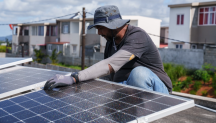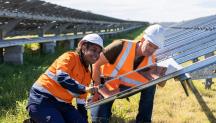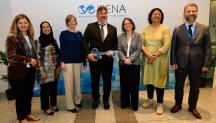

-
-
IRENA (2019), Future of Solar Photovoltaic: Deployment, investment, technology, grid integration and socio-economic aspects (A Global Energy Transformation: paper), International Renewable Energy Agency, Abu Dhabi.
Copied
/-/media/Files/IRENA/Agency/Publication/2019/Nov/IRENA_Future_of_Solar_PV_2019.pdf?rev=d2e0fb395422440bbeb74c69bbe2dc99
Copied
Future of Solar Photovoltaic
Newsletter
Deployment, investment, technology, grid integration and socio-economic aspects
Reducing carbon dioxide (CO2) emissions is at the heart of the world’s accelerating shift from climate-damaging fossil fuels towards clean, renewable forms of energy. The steady rise of solar photovoltaic (PV) power generation forms a vital part of this global energy transformation.
In addition to fulfilling the Paris Agreement, renewables are crucial to reduce air pollution, improve health and well-being, and provide affordable energy access worldwide. This paper from the International Renewable Energy Agency (IRENA) presents options to speed up deployment and fully unlock the world’s vast solar PV potential over the period until 2050.
See the executive summary in English or Spanish (Español).
The analysis follows the REmap Case outlined in IRENA’s Global Energy Transformation roadmap, which highlights ways to step up the energy transformation over the next three decades in contrast to current plans.
Specifically, the paper highlights the growth needed in solar PV to achieve climate goals. It also offers insights on cost reduction, technology trends and the need to prepare electricity grids for rising shares of solar PV.
Among the findings:
- Accelerated solar PV deployment coupled with deep electrification could deliver 21% of the CO₂ emission reductions (nearly 4.9 gigatonnes annually) by 2050.
- Solar PV could cover a quarter of global electricity needs by mid-century, becoming the second largest generation source after wind.
- Global capacity must reach 18 times current levels, or more than 8 000 gigawatts by 2050.
- Asia would continue to dominate solar PV use, with over 50% of installed capacity, followed by North America (20%) and Europe (10%).
- Solar PV project costs, already below marginal fossil-fuel costs in global terms, are set to decline further in the decades ahead.
- Mobilising finance will be key, with IRENA’s roadmap estimates implying a 68% increase in average annual solar PV investment until 2050.
- Solar PV is a fast-evolving industry, with innovations along the entire value chain driving further, rapid cost reductions. Floating PV is a prime example, with global cumulative installed capacity exceeding one gigawatt in 2018 and clear potential for rapid growth.
- Rooftop solar PV systems have spread rapidly thanks to supporting policies, such as net metering and fiscal incentives.
- Energy transformation brings socio-economic benefits. The global solar industry could employ over 18 million people by 2050.




